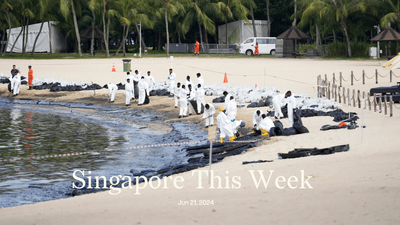Society: Food, a roof, and clothing—that’s all you need
How much money does one need every month to live in Singapore? Surely it differs from Yishun in the north to Sentosa in the south. Yet, some commonly accepted average measure is useful for policymakers. The Minimum Income Standard (MIS) 2023 report, produced by Nanyang Technological University (NTU) and the Lee Kuan Yew School of Public Policy (LKYSPP), has suggested the following MIS budgets: S$3,369 for a single parent with one child aged 2–6 years old; S$6,693 for a couple with two children aged 7–12 and 13–18 years old; and S$1,492 for a single elderly person 65 years and older. But some 30 percent of working households earn less than the amount required to meet basic needs, it said. Policy recommendations include: a “living wage, a universal wage floor”; major reform to the “retirement income regime”; and improvements to policy processes, which will enable, for instance, government assistance to “be pegged to current prices to keep up with actual needs”. This is the third MIS report in four years by a team led by Ng Kok Hoe, who founded the Social Inclusion Project at LKYSPP, and led the first nationwide street count of homelessness in Singapore. Ng and Teo You Yenn, associate professor at NTU and report co-author, are arguably the most prominent academics examining poverty in Singapore. Their stellar work has again drawn a rebuttal from the government, in the form of a joint statement by three ministries. A major disagreement stems from differing delineations of “needs” versus “wants”. The government questioned, for instance, whether jewellery and overseas holidays are basic needs. Yet, in keeping with what their focus groups consider as needs, researchers allocated, for the former, a mere S$50 per year—“things like earrings, hair clips and brooches”—and, for the latter, a 4-day-3-night trip to Ipoh and Port Dickson by coach. Are those needs or wants? We agree with the researchers (and their focus groups). Living is not simply about surviving but, as they say, about having “...a sense of belonging, respect, security, and independence.” That said, both the researchers and policymakers, caught up in their jargon and definitions, may have been eclipsed by this middle-aged auntie’s retort on local television: “I ask you, money where got enough or not enough?”
Society: Public transport fare hikes to lead to approx S$137.4m revenue increase for operators
From December 23rd, adult commuters can expect to pay 10 to 11 cents more per bus and train journey when using a card. Students, seniors, low-wage workers and people with disabilities who have concessionary card fares will pay four to five cents more per trip. (Cash customers on buses will see the highest increases across groups.) Hybrid monthly passes for heavy-use concessionary groups, however, will fall in price. All this comes after the Public Transport Council (PTC), which regulates Singapore’s public transport fares, permitted a seven percent increase in fares, while deferring the remaining 15.6 percent of the proposed 22.6 percent hike (itself a combination of a 12 percent inflationary adjustment and a 10.6 percent deferral from the last hike). This will result in an additional S$137.4 million for the Land Transport Authority, SBS Transit Rail and SMRT Trains. The government will also provide them with a subsidy of S$300m to cover the cost of deferring the allowable fare adjustments. All this is on top of the more than S$2bn, or S$1 per journey, that the government said it pays annually to subsidise public transport services. And to further help households cope with these higher costs, PTC will require SBS Transit and SMRT Trains to contribute a larger portion of its expected revenue increase to the Public Transport Fund—15 and 30 percent respectively. Rising public transportation costs is a perennial pain point for commuters faced with escalating costs of living. Some have suggested that transport companies cut back on frequencies to reduce operational costs, and make fare hikes the last resort. (The two firms make healthy profits and their top executives typically earn close to or above seven-figure salaries). But any reduction in services will likely increase waiting times and overcrowding, leading to disgruntled commuters anyway. According to the Global Transport Index, Singapore has the joint 10th best public transport options in the world but the fourth cheapest—costlier only than Buenos Aires, Tehran and Rio de Janeiro. Yet, the issue is perhaps less about the absolute cost of transport than the overall financial burden for people at the bottom, like the 30 percent of households below the MIS. For them, every additional cent counts. Everything in perspective.
Society: Only some people from Anxi are fraudsters
After several people from Anxi, China were arrested in one of Singapore’s largest anti-money laundering operations, local clan associations have urged Singaporeans not to stigmatise people from Anxi. It was “deeply [hurtful]” to read local Chinese media describe Anxi as a “fraudsters’ hometown”, they said. A Fujian county known for tie guan yin (Iron Buddha tea), Anxi has gained prominence in recent years for its scams: residents have been involved in fraudulent schemes both in China and overseas, running telecommunications fraud (including love and impersonation scams), masquerading as fortune-tellers, or swindling others in business deals. “For more than 20 years, the Quanzhou and Anxi police alone have captured tens of thousands of Anxi suspects involved in fraud…” a Chinese police officer told Liaowang magazine. Village officers are having difficulty resolving this issue, as younger Anxi residents find it “impossible to lead a decent life just farming and planting tea.” Tempted by their neighbours’ and friends’ luxurious lifestyles, many of them are turning to criminal activity. According to Yeo Hoon Chong, chair of the Singapore Ann Kway Association, three Anxi businessmen offered to make a monetary donation in exchange for honorary titles in the clan association. Yeo now believes they might have done so to gain faster access to a Singapore citizenship or permanent resident status, perhaps to aid criminal activity. Clan association leaders, including Yeo, say their stringent membership criteria have thankfully kept questionable characters at bay. Clan associations first sprouted up in the late 19th Century so that people who shared the same surname, dialect group, or originated from the same Chinese county could lean on each other for support—social, financial, political—in colonial Singapore. While their influence is relatively limited today, clan associations still play an important role in our social fabric: “...a reminder that just because of a common surname, a common dialect or a common geographic origin, and not by choice, people can stick together and be loyal to each other,” Pang Sze Yunn told Jom. Today, we’ve published a Q&A with Pang, who spearheaded a project to translate her family’s 600-year-old genealogy book. She’s urged all Singaporeans to document their own family histories, including the unflattering, messy bits. We’ll probably discover that money-laundering and scams are not the preserve solely of the people of Anxi.
History Weekly by Faris Joraimi
Last weekend, a visitor to the Peranakan Museum, an extension of the Asian Civilisations Museum (ACM), made a public Facebook post on a change made to the wall text for an ongoing temporary exhibition, “Her Kebaya”. Having seen the exhibit myself, I considered the selection to be a refreshing take on the celebrated women’s garment, one that didn’t prioritise the ubiquitous Chinese Peranakan matriarch. On display instead was an array of kebaya types and wearers: an embroidered velvet kebaya panjang, a stunning lace piece worn by a Dutchwoman, another by the famous keroncong-singer Kartina Dahari and even a contemporary example made for ex-president Madam Halimah Yacob. The original wall-text read,
“This showcase celebrates the kebaya, a blouse worn by women of many different communities in South-east Asia since the 15th century. Rooted in the traditional fashion of the Malay-Indonesian world, the kebaya is an integral part of Singapore’s Malay and port-city heritage, echoing the multiculturalism and plurality of the region.”
Now, about two months since the exhibition opened, an edited version has deleted those parts that attribute the kebaya to the “Malay-Indonesian world” and Singapore’s Malay heritage, instead emphasising its “South-east Asian” roots. The following paragraph now adds mention that only the kebaya types presented in this show specifically are from the Malay world. I won’t speculate on why the change was made, but what seems like a paraphrase actually changes the whole picture. Essentially, Malay-Indonesian world and South-east Asia refer to different places. The former still arouses anxiety in many Singaporeans, who imagine themselves as a “Chinese dot in a Muslim sea”. Whereas South-east Asia feels more neutral and inclusive. But is it really? All names are, to an extent, ideological. That one has to blot out the other shows Singapore’s unresolved relationship with its historical geography, which remains a contested terrain.
(Note: ACM did not respond to a request for comment.)
Arts: Remembering Chandran Nair
Poet and publisher Chandran Nair passed away in Paris this week at 78. His career spanned multiple decades, beginning in secondary school. In 2010, Ethos Books published an anthology of his work, Reaching For Stones: Collected Poems (1963-2009). Nair’s contributions to Singapore’s literary scene were not limited to writing. He was the founding president of the Society of Singapore Writers in 1976. He also started publishing houses Times Books, now Marshall Cavendish, and Woodrose Publications, which counts among its writers Angeline Yap, a poet, Geraldine Heng, a professor of English and comparative literature, and Tharman Shanmugaratnam, Singapore’s president. Literary non-profit organisation Sing Lit Station is planning a memorial for Nair, tentatively scheduled for September 28th at 8pm.
Arts: Fresh charges for Ken Lim
Music industry veteran Ken Lim has picked up an additional charge of insulting a woman’s modesty, this week. He currently faces seven charges of insulting the modesty of women and molestation. In total, there are five alleged victims, many of them female music artistes, known to the court for incidents that took place between 1998 and 2021. During this time, Lim was a judge on music competition show Singapore Idol, an executive producer for television series and government campaigns, and the executive director of label Hype Records (whose office was reportedly the scene of several incidents). Lim faces fines, up to a year’s jail for each count of insulting a woman’s modesty, and up to two years for molestation if found guilty. His lawyers have indicated that they intend to “vigorously contest the allegations”.
Tech: Data centres surge to meet demand
Increasing artificial intelligence (AI) and cloud adoption in the region has driven demand for data centres. According to data cited from Kearney, South-east Asia’s data centre market expects an annual growth rate of 17 percent over the next five years, outpacing data centres’ global average growth rate of 12 percent. It’s no surprise then that leading global investment firm KKR has purchased 20 percent of Singtel’s regional data centre business for S$1.1bn. The deal gives KKR a stake increase to 25 percent by 2027 at the same valuation, upon the completion of customary closing conditions and regulatory approval. From Singtel’s perspective, it can leverage KKR’s expertise to expand its regional data centre business around South-east Asia. Singtel’s data centre portfolio is predicted to have a capacity of over 155 megawatts by 2025, once its new projects in Indonesia, Singapore and Thailand are operational, positioning the firm to meet this rising demand. KKR, meanwhile, is looking to expand its portfolio of data centres in APAC—which currently comprises 23.5 percent of its capacity from 64 data centres globally.
Tech: Ryde and die?
Some tech companies might think that the IPO window is open again after the listing of Arm Holdings last week. Ryde, a Singapore-based platform known for mobility and quick commerce, is seeking to raise up to US$17m (S$23.6m) through its listing on the New York Stock Exchange, according to its Form F-1 filed with the US Securities and Exchange Commission. The key highlights from the filing indicate mixed prospects for the company. Its revenue grew 42 percent year-on-year in 2022, primarily driven by membership subscription fees and advertising, while its Gross Merchandise Value saw a 11-percent decline despite increased expenditures on incentives. The company’s losses have been widening, increasing from 20 percent of revenue in 2021 to 56 percent in 2022. Furthermore, the company has shown a negative cash flow from operating activities of about US$2.9 million in 2022, demonstrating less than a year of financial runway at its current operational pace. Ryde has just 2.5 percent of Singapore’s mobility market (compared with Grab’s 50 percent and Gojek’s 18 percent). While the challenges are evident, smaller tech companies like Ohmyhome have similarly attempted IPOs with some success. Ohmyhome initially debuted for US$4 (S$5.5) per share in March, raising US$11.2m (S$15.2m). It is currently trading at US$1.87 (S$2.56) per share (as of Thursday 12pm). Ohmyhome and Ryde will hope to turn a corner soon. Because, if loss-making firms raise cash only to delay the inevitable, new investors might start feeling like they’ve been taken for a Ryde.
If you enjoy Jom’s work, do get a paid subscription today to support independent journalism in Singapore.







